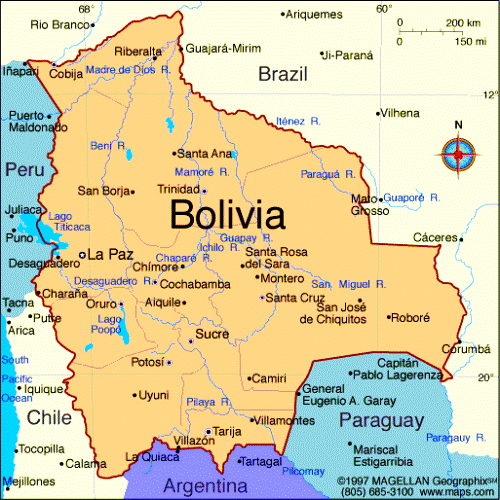Sunday, January 30, 2011
01/30/11
Bolivia is an impoverished country located in South America. The population is about 9.35 million people, one half is indigenous Amerindian. Over half of the population speaks spanish.

Similar to the U.S, Bolivia has many different types of social media. For example, there are dating sites, social networking sites, and cellular services. Jhoos is a popular, free online dating service.

BestMuslim.Com is an online Muslim marriage and matrimonial service.

One of the main cellular services in Bolivia is Millicom. Millicom, more commonly known as TIGO, replaced other national services because it is practical and international. About seven million people in Bolivia use cellular devices.

Facebook was made accessible to the public in 2004. This social networking site is one of the most popular websites in the world. Facebook enables people all over the world to communicate with others locally, nationally, and internationally. There are many different amenities on facebook, including the ability to share pictures and thoughts. In 2009, roughly four million people were using facebook in Bolivia. Approximately fifty-five million people were using it in the U.S.
Although Bolivia is not a very wealthy country, the people living there still have access to many different types of social media.
http://www.worldvision.org/content.nsf/sponsor/sponsor-bolivia?Open&lpos=lft_txt_Bolivia
http://www.theodora.com/wfbcurrent/bolivia/bolivia_economy.html
https://www.cia.gov/library/publications/the-world-factbook/geos/bl.html
http://www.theodora.com/wfbcurrent/bolivia/bolivia_economy.html
https://www.cia.gov/library/publications/the-world-factbook/geos/bl.html
"Applied Ideas" BP2
The following is a list of how space, power, precedent, order, experience, principles, site, scale, technology, and surface is applied to UNCG's campus.
[SPACE]
Campus has a puzzle piece-like organization, utilizing the space and creating harmony between where there are and aren't buildings.
[POWER][PRECEDENT][ORDER]
Power, Precedence, and Order can be seen on campus by looking at the placement and prominence of important buildings.
[EXPERIENCE]
All of the buildings on campus are constructed of similar materials, creating an awareness that each one is part of a whole. The following diagram shows the likeness of the buildings on campus. I found the pictures through google images.
[PRINCIPLES]
The architecture emphasizes the learning buildings.
[SITE]
The most important buildings on campus are in the center, almost as though they are protected by the others.
[SCALE]
Scale is shown on campus in the way that it is spread out, using the space as well as possible.
[TECHNOLOGY]
Paths through campus help minimize walking distance and to make all of the buildings easily accessible.

[picture taken from http://www.uncgspartans.com/information/About_UNCG]
[SURFACE] ^^^
The campus's surface is more vertical than horizontal. It is located on a flat plane but all of the buildings shoot up off it; there are little to no one story buildings on campus.
Thursday, January 27, 2011
1/27/11
Our first assignment of the semester was to create a box out of card board or foam core. The box was to be 12x12x18 with a 12" opening. The next step was to cut holes into the box, which we would shine a light through, to create four different "spaces" within it. We were allowed to use bristol board and bamboo skewers in any way we could imagine to help create four spaces.
I made my box and presented it at the first critique, it was full of holes and a little too chaotic. I re-made the box and at the second critique I presented it with one "U" shaped cut and four holes punched in the top. Inside, I had a bristol board, 3-D, elongated triangle to emphasize the shape of the light coming through. Also, I put a foam core wedge in the box to re-direct the light and create another space.
Sunday, January 23, 2011
"Putting History Into Practice" BP1
While walking across campus I noticed circular, grouped, and stacked architecture.
CIRCULAR
Circles represent the sun, moon, and sacred spots.
Circular architecture can be seen in the Elliot University Center (EUC) on UNCG's campus.
The EUC is a gathering place for people all over campus. You can buy groceries, meals, books, supplies, and the big auditorium is also located in the EUC. The following sketch is of what the ceiling of the EUC looks like. It's like a tower that extends from the first floor to the highest floor.
GROUPED
Groups of things represent groves or trees, reaching vertical, and groups of people.
Grouped architecture can be seen on almost all of the buildings on campus.
Two examples are the windows on the buildings and the railings outside some of them.
STACKED
Stacks represent mountains, gatherings, and resources.
My favorite example of stacked architecture is seen in the building structure of the library on campus.
The library's architecture seems to represent mountains (from it's height), gatherings (study groups and a lot of people gather there), and resources (books).
(other than the drawing, pictures were taken from the photo gallery on the UNCG website, they were then taken and edited to emphasize the aspects that I felt important.)
Tuesday, January 18, 2011
Subscribe to:
Posts (Atom)







